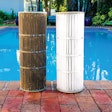
Any list of the achievements of the pool industry — alongside the great waterscape paintings in real life, the advances in sanitizing equipment and just professionalization in general — must include the victory of the VSP over the large, single-speed pumps that dominated the pool industry in the 20th century.
At that time, when selling a pool, builders would tout the high-horsepower pumps that would be included in the package in the same way a car salesman might trumpet the size and power of a Corvette’s V8.
Little was understood about hydraulics and the massive energy losses that result when a 3-horsepower pump is run for 12 hours at 3,450 rpm, cramming water through a 1 1/2-inch pipe. In terms of efficiency, it would be as if that Corvette’s 6.2L V8 was paired with a transmission made of oatmeal.
And so the single-speed pumps churned on, and all over the world, tiny hands on millions of kilowatt meter dials spun like crazy, losing megawatts of power to friction, wasting homeowners money and spewing unnecessary tons of smoke into the air.
Though variable-speed pumps were in use in other industries in the 20th century, it wasn’t until the early 2000s that they began making inroads into the pool industry among early adopters looking to claim the mantle of cutting-edge technology.
Gradually, the idea began to circulate: Low-flow water movement could somehow save a tremendous amount of electricity. Little by little, builders, retailers and service providers became familiar with some basic physics, and something called “The Affinity Law of Fluid Dynamics,” which stated in essence that running a pump at half speed required only 12.5% of the energy. That basically, you could move the same amount of water through a filter with a quarter of the energy and cost, if you just did it slower.
For a common sense industry, that seemed to defy common sense. I remember one argument I ran into constantly. Guys would say, “Okay, if you pump at half speed, you use half the power, I get that. But it takes twice as long to turn over the pool, so you haven’t saved a thing. Plus, the damned thing is more expensive!”
It literally took years to get it across that when you pump at half speed, you expend 1/8 the power because you lose so much less energy in the pipes. And as a consequence, VSPs pay for themselves in a shockingly short amount of time, and then pay off like an investment in Berkshire Hathaway.
And indeed, like any technological revolution, the transition was awkward and the path was rocky in those early years of acceptance. Some of the first VSP models had bugs that needed to be worked out, and out in the field, service pros immediately noticed that if you started pumping slowly, other components of the pool system, such as skimmer weirs to in-floor cleaning systems, did not work properly.
It took a while to realize the full potential of this enormous change. Components would have to be redesigned and maintenance methods changed, but one thing was obvious, right from the start — pool chemistry worked a lot better when you kept the water moving and didn’t have long periods where it sat stagnant.
California gave the movement a big boost in 2008 with regulations that stipulated that all pool filtration pumps 1-horsepower or greater (which is most of them) have two or more speeds.
This was a critical step. With the No. 1 pool market mandating the move toward low-speed pumping, and consumer incentive programs (rebates) going full steam, consumers started buying in and technological development and service pro training shifted into high gear.
In those years after California’s Title 20, many builders and retailers joined the VSP revolution, to their great advantage. They grew confident and skilled in explaining the savings that VSPs provide. In time, many of these companies simply drifted away from single-speed pumps entirely, and essentially, they mandated VSPs on new construction and strongly recommended them on replacement. At the same time, more large pool building states, such as Florida and Arizona, among others, emulated Title 20 in their own regulations and codes.
Nevertheless, a portion of the pool industry remained steadfast in their dedication to single-speed pumping. It was easy to circumvent state regulations if you wanted to, and many did, pointing to the low initial purchase price of a single-speed pump and the low cost of simply replacing a burnt out single-speed motor.
Toward the latter half of the 2010s, the U.S. Department of Energy began working on energy regulations for the pool industry. It didn’t know exactly how to approach the problem, and left to its own devices, likely would have come up with a cumbersome law well out of touch with pool industry realities. Thankfully, a group of pump industry experts stepped forward to help guide the process and shield the industry from too many unintended consequences.
The result, the “Department of Energy Dedicated Purpose Pool Pump (DPPP) Regulations,” was the most dramatic and sweeping pool law in history. Much more powerful than Title 20-type regulations, DOE DPPP outlawed the manufacture of most single-speed pool pumps on the market.
The law actually mandated a certain level of pump efficiency, which for the most part, only VSPs could reach. Based on technology at the time, that meant all single-speed and two-speed inground pool pumps in the hydraulic horsepower range of .711 to 5.0 were no longer legal to produce.
A year ago, on July 19, 2021, DOE DPPP went into effect, and those inefficient pumps began to disappear from distributors’ shelves. In the field, as those pumps continue to wear out, they are being thrown into the landfill of history and replaced by pumps that save electricity.
How much electricity are we saving? According to the Pentair Pool Pump Calculator, an online tool for calculating VSP savings, switching a 2-hp single-speed pump to a VSP saves about $1,200 and 800 kWh in one year.*
Using a number of reasonable assumptions and some ballpark guesses**, it’s possible to get a vague sense of what has been accomplished in the entire VSP revolution over the last 20 years — that is, the general order of magnitude of how much electricity has been saved.
To date, the VSP revolution has saved enough electricity to:
- Fully charge 240 million Teslas
- Drive an average electric car 34 billion miles
- Power 13 million average U.S. homes for one month
- Power 1 million average U.S. homes for one year
- Take three coal-fired power plants offline for one year
I’d say it’s been worth it.
* Pool pump located in zip code 90072 (Los Angeles area) 2-hp single-speed pump, run 12 hours per day, 8 months of use $0.19 per kWh
** 800 kWh per pump, per year Total kWh saved: 12 x 10^9 kWh
This article first appeared in the July 2022 issue of AQUA Magazine — the top resource for retailers, builders and service pros in the pool and spa industry. Subscriptions to the print magazine are free to all industry professionals. Click here to subscribe.











































